“When I imagine Troitzky in his Siberian forest, surrounded by howling wolves, analyzing night after night whether king plus four knights can always beat king plus queen, that is great. That’s what chess is all about, only you have to be a chess player to appreciate it. How can you explain to a non-chess player that within chess there is a little world of endgame studies…within which there is a microcosm made of utterly mad men analyzing four knights against queen.”
- Tim Krabbé (Chess Curiosities)

Alexey Troitzky
Alexey Troitzky (1866-1942) was one of the founding fathers of the modern endgame study. He was a prolific author with more than 1300 endgame studies to his credit. Troitzky’s life spanned the latter half of the 19th Century and the early half of the 20th Century. Living as he did in Russia he was a witness to a turbulent era. First, he saw the decline and fall of the Tsar and then the 1917 Revolution followed by the Civil War and the Great Terror. He survived it all and in the end it was the siege of Leningrad that claimed his life.
He was a forest warden and the isolation from the hustle and bustle of city seems to have suited his creative work. It was only in his post-retirement years that he returned to Leningrad, his old city and settled there till the end. Here he wrote his last work, Collected Chess Studies (1935) and in this task he was ably assisted by Alexander Herbstman (1900-1982) who was to become a great composer in his own right thereafter. Years later the disciple was to write about his association with the master and his last days:
Troitzky was 68 in the year I moved to Leningrad, and that was when he came to live there too. It was the time when he prepared his collection of studies to be published. He was alone, and I helped him to check and annotate them…
On the outbreak of war (ie, in 1941, when German forces invaded the USSR, not the earlier September 1939 date familiar to Britain and France-A.J. Roycroft, Ed.) the threat to Leningrad became very real. I hurried to Alexey and tried to persuade him to leave with me. He rejected the idea. He died of starvation during the long blockade.
- 'Memories of Great composers', Alexander Herbstman (E.G. Magazine #65, July 1981)
Troitzky formulated the principles of composition in endgame studies. He also offered a classification of themes like domination, stalemate and underpromotion.
He had made a deep study of endgame theory and the work of composers like Johann Berger (1845-1933) before him.
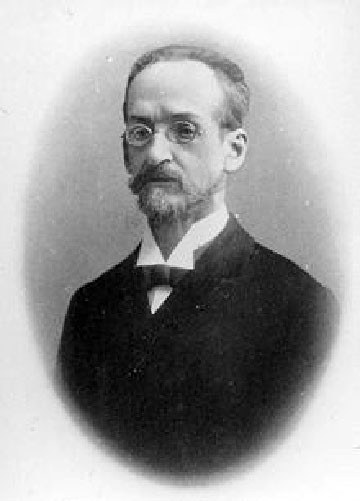
Johann Berger
A case in point is the theme of two knights versus pawn. Here it was Chapais, an 18th century player from France who drew attention to a paradox. As is known, two knights cannot force a mate. However, if the other side has a pawn that can be blocked by one of the knights, mate becomes possible. The idea was right, but the method was a problem.
According to Brian Gosling it was Rev. Horatio Bolton (1793-1873) who demonstrated how to execute the plan and the following problem was included in Theorie und Praxis der Endspiele (Leipzig 1890), Berger’s standard work in those days.
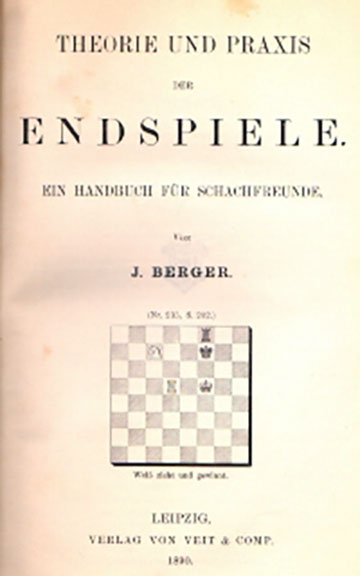
One of Troitzky's great predecessors
Rev. Horatio Bolton's solution (1840)

[Event " "]
[Site "?"]
[Date "1840.??.??"]
[Round "?"]
[White "?"]
[Black "?"]
[Result "*"]
[SetUp "1"]
[FEN "8/8/8/5K2/7k/7p/7N/7N w - - 0 1"]
[PlyCount "17"]
[EventDate "1840.??.??"]
1. Nf2 $1 Kh5 2. Nfg4 Kh4 3. Kg6 Kg3 4. Kg5 Kg2 5. Kf4 Kh1 6. Kf3 Kg1 7. Kg3
Kh1 8. Nf3 h2 9. Nf2# *
Troitzky was inspired by this composition among others and it led to his formulation of the well-known Troitzky Line. Although the two knights versus pawn ending is rarely seen in practical play, it does occur from time to time as pointed out by Gosling. Here is an illustration from MegaBase:
Modern example of win with two knights vs pawn

[Event "Doeberl Cup, Canberra "]
[Site "?"]
[Date "2011.??.??"]
[Round "?"]
[White "Solomon, SJ."]
[Black "Steadman, M."]
[Result "*"]
[Annotator "Karsten Müller"]
[SetUp "1"]
[FEN "8/7k/5K2/8/5N2/5p2/5N2/8 w - - 0 92"]
[PlyCount "31"]
[EventDate "2011.??.??"]
{White should have played} 92. Ne6 $1 ({In the game Solomon, SJ-Steadman,M
played in Canberra 2011 White went wrong with} 92. Ng6 $2 {and only after an
exchange of errors he found the method outlined here to win.}) 92... Kh6 93.
Ng7 Kh7 94. Nf5 Kg8 95. Ke7 $1 {not allowing his counterpart to escape to the
queenside} Kh7 96. Kf7 Kh8 97. Kg6 Kg8 98. Ng7 Kf8 99. Kf6 Kg8 100. Ne6 Kh7
101. Kg5 Kg8 102. Kg6 Kh8 103. Kf7 Kh7 104. Ng4 f2 105. Nf8+ Kh8 106. Nf6 f1=Q
107. Ng6# {A picturesque position!} *
A Troitzky work can be deep and complex or delightfully simple. Here are a few examples. Before looking at the solution, readers are encouraged to try their hand before seeing the solutions.
1) Alexey Troitzky, Shakhmatny Zhurnal 1893
The following piece was Troitzky’s first composition. It’s a problem, not a study. Here White has a few issues to deal with. Apparently his own king is hindered by the Black bishop on c1 and the pawn on d2. Meanwhile his knight on c5 is threatened by the pawn on d6. So how does he get to surrender the Black king?
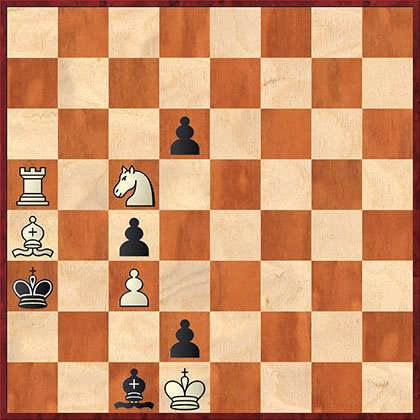
White to play and mate in three moves
[Event " "]
[Site "?"]
[Date "1893.??.??"]
[Round "?"]
[White "?"]
[Black "?"]
[Result "*"]
[SetUp "1"]
[FEN "8/8/3p4/R1N5/B1p5/k1P5/3p4/2bK4 w - - 0 1"]
[PlyCount "5"]
[EventDate "1893.??.??"]
1. Kc2 $1 d1=Q+ 2. Kb1 dxc5 3. Bxd1# *
2) Alexey Troitzky, Novoye Vremya 1895
Here White has a bishop and knight against the queen. To add to his worries Black is threatening both 1...gxh5 and 1...Qxf4. However, he has a quiet move that takes the wind out of his opponent’s sails.
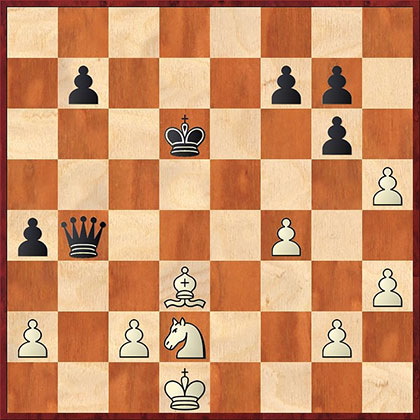
White to play and win
[Event "Novoye Vremya "]
[Site "?"]
[Date "1895.??.??"]
[Round "?"]
[White "?"]
[Black "?"]
[Result "1-0"]
[SetUp "1"]
[FEN "8/1p3pp1/3k2p1/7P/pq3P2/3B3P/P1PN2P1/3K4 w - - 0 1"]
[PlyCount "5"]
[EventDate "1895.??.??"]
{Black is threatening both 1...gxh5 and 1...Qxf4.} 1. h6 $1 ({Playing for
knight forks immediately with} 1. c3 $2 Qxf4 2. g3 {would be premature on
account of} Qh6 $1 $19) 1... gxh6 2. c3 Qxf4 3. g3 $1 {and the queen is
trapped. It's only now that the point of 1.h6 is revealed. The queen cannot
retreat to h6 as it is occupied by a Black pawn.} 1-0
3) Alexey Troitzky, Novoye Vremya 1896
In this position White lives dangerously. Both his pawns are under threat. The knight who can help has not even stirred out of his position. Then the monarch remembers the famous saying by Marshal Foch, “My center is giving way, my right is in retreat; situation excellent. I shall attack.” The charge of The Light Brigade begins!
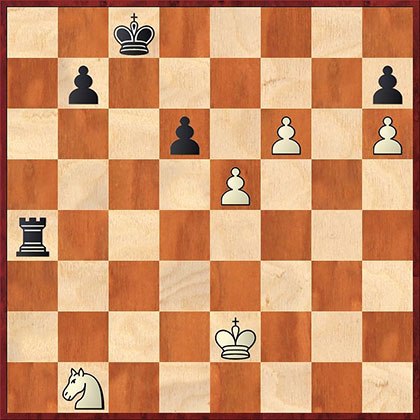
White to play and win
[Event "Novoye Vremya "]
[Site "?"]
[Date "1896.??.??"]
[Round "?"]
[White "?"]
[Black "?"]
[Result "1-0"]
[SetUp "1"]
[FEN "2k5/1p5p/3p1P1P/4P3/r7/8/4K3/1N6 w - - 0 1"]
[PlyCount "5"]
[EventDate "1896.??.??"]
1. Nc3 Ra5 (1... Rf4 2. Nd5 Rf5 3. Ne7+ $18) 2. f7 Rxe5+ 3. Ne4 $1 {If 3...
Rxe4 4.Kf3 and if 3...Rf5 4.Nxd6+ wins.} 1-0
4) Alexey Troitzky, Shakhmaty Zhurnal 1901
Here Black threatens to promote the pawn to queen. It appears White
has no more than a few spite checks to ward off the disaster. What would
you advise him to do?
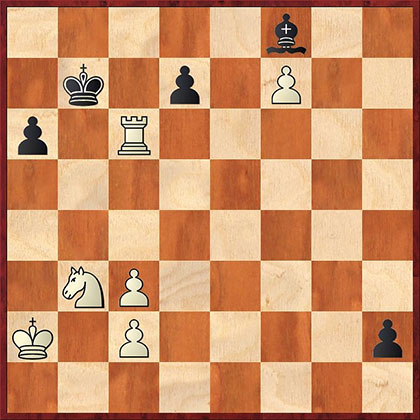
White to play and win.
[Event "Shakhmaty Zhurnal "]
[Site "?"]
[Date "1901.??.??"]
[Round "?"]
[White "?"]
[Black "?"]
[Result "1-0"]
[SetUp "1"]
[FEN "5b2/1k1p1P2/p1R5/8/8/1NP5/K1P4p/8 w - - 0 1"]
[PlyCount "17"]
[EventDate "1901.??.??"]
1. Na5+ $1 Ka7 ({not} 1... Kb8 2. Rb6+ Kc7 3. Rb1 $18) 2. Rc7+ Ka8 ({If} 2...
Kb8 3. Rb7+ Kc8 4. Rb1 $18) 3. Rc8+ Ka7 4. Rxf8 h1=Q 5. Rb8 $1 Qd5+ (5... Kxb8
6. f8=Q+ $18 {is of course out of question.}) 6. Kb2 $1 Qxf7 7. Rb7+ Ka8 8. Nc6
$3 {the crowning glory} Kxb7 (8... Qg8 9. Ra7#) (8... Qf2 9. Rb8#) (8... dxc6
9. Rxf7 $18) 9. Nd8+ 1-0
5) Alexey Troitzky, First/Second Prize, Magyar Sakkvilág 1935
In this last position Black threatens to win on the spot with 1…e2xd1=Q+.
If
White saves the knight, Black promotes the pawn anyway. But we are in
the
age of chivalry. So how do the gallants save the day?
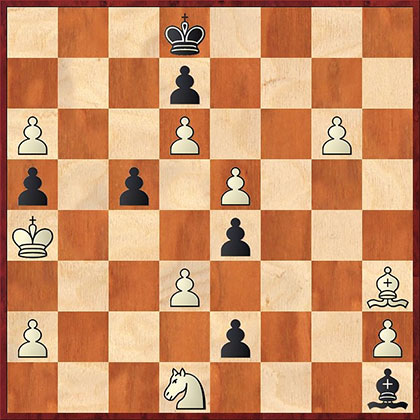
White to play and win.
[Event "Magyar Sakkvilág "]
[Site "?"]
[Date "1935.??.??"]
[Round "?"]
[White "?"]
[Black "?"]
[Result "1-0"]
[SetUp "1"]
[FEN "3k4/3p4/P2P2P1/p1p1P3/K3p3/3P3B/P3p2P/3N3b w - - 0 1"]
[PlyCount "19"]
[EventDate "1935.??.??"]
1. Nc3 $1 e1=Q 2. g7 ({not} 2. a7 $2 exd3 3. g7 Bc6+ 4. Kb3 Qg1 $19) 2... Qg1
3. a7 exd3 $1 ({If} 3... Qd4+ 4. Kb5 $1 Qb4+ 5. Ka6 $18) 4. Bg2 $1 {Here comes
the first Novotny.} Qd4+ $1 (4... Bxg2 5. g8=Q#) (4... Qxg2 5. a8=Q+ $1 Qxa8 6.
g8=Q#) 5. Kb5 $1 Qb4+ 6. Ka6 Qc4+ 7. Kb6 $1 Bxg2 8. Nd5 $1 {Now we have the
second Novotny.} Qxd5 (8... Bxd5 9. g8=Q+ $1 Bxg8 10. a8=Q#) 9. a8=Q+ $1 Qxa8
10. g8=Q# 1-0
In the twilight of life Troitzky was working on a new collection of his studies. After his demise the manuscript and other papers were never found. Then other composers like Korolkov, Chekhover and Umnov set about tracing his studies from every available source. Thereafter they produced new anthologies of Troitzky with valuable analysis. In more recent times Nikolai Kralin and Oleg Pervakov collaborated with late Jan van Reek to fix errors in Troitzky’s studies and produce a comprehensive collection of his work for Harold van der Heijden’s Endgame Study Database.
It’s a valuable legacy.
































